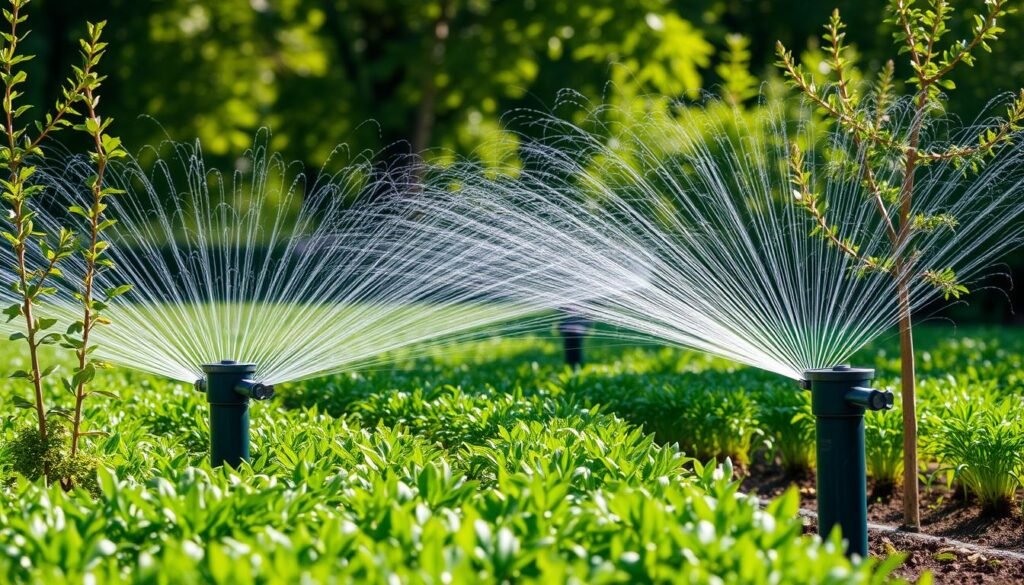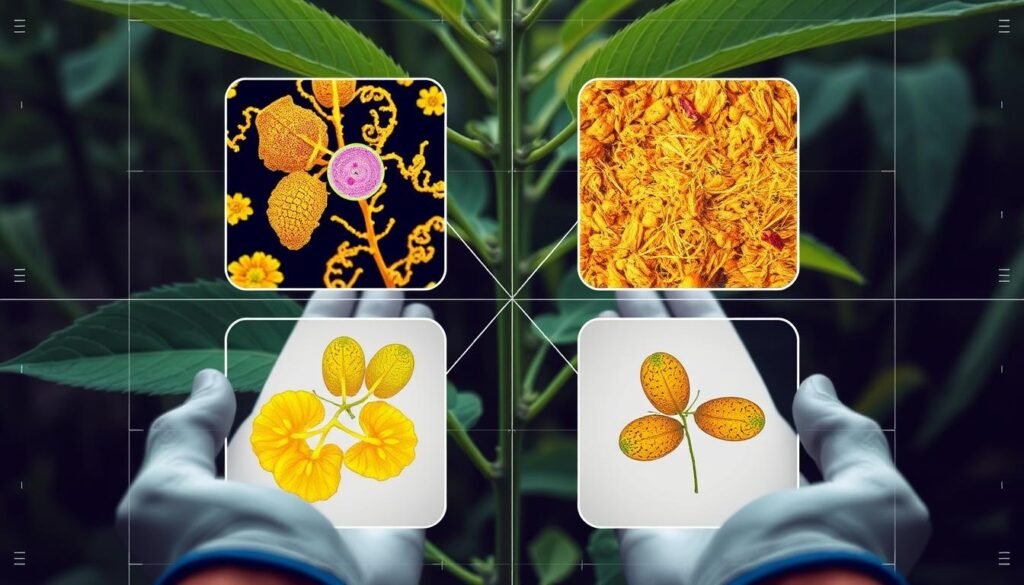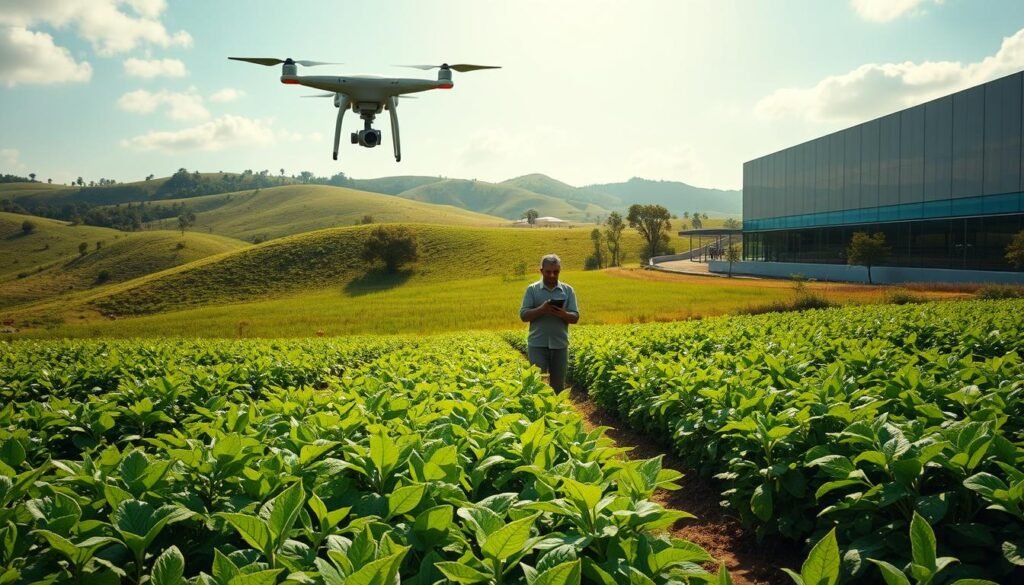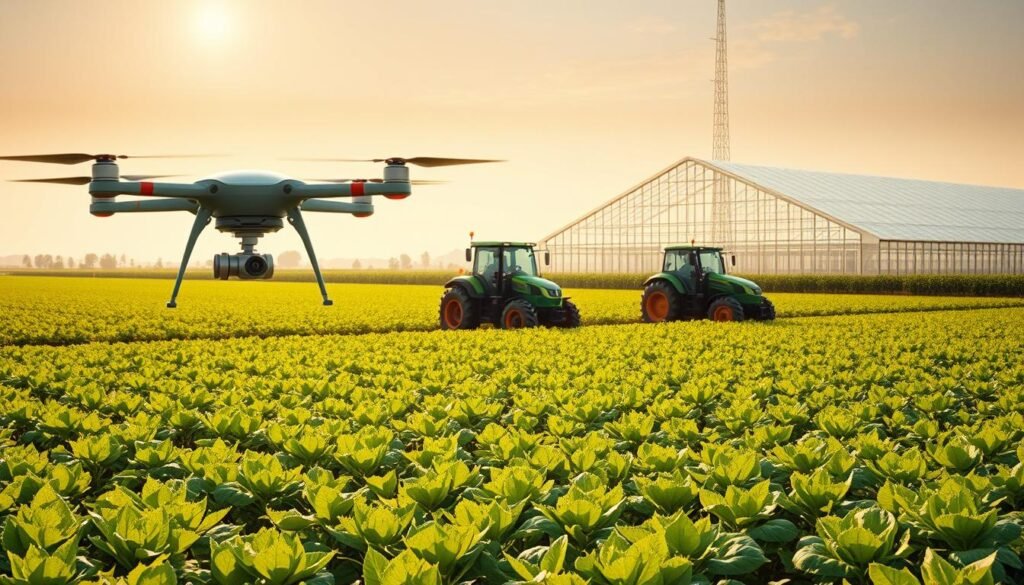Can technology hold the key to feeding the world’s growing population? As the global population continues to rise, the agricultural sector faces increasing pressure to produce more food with limited resources.
The answer lies in the adoption of technologies like artificial intelligence that are revolutionizing traditional farming practices. In Pakistan, farmers are leveraging AI-powered systems to make data-driven decisions, improving productivity and sustainability.
This transformation is crucial for addressing critical challenges in agriculture, including food security, climate change adaptation, and resource optimization.
Key Takeaways
- AI technologies are revolutionizing traditional farming practices globally.
- AI helps farmers make data-driven decisions to improve productivity.
- The integration of AI in agriculture maximizes yields while minimizing environmental impact.
- Pakistan’s agricultural sector can benefit significantly from AI adoption.
- AI addresses critical challenges like food security and climate change adaptation.
The Agricultural Revolution: AI’s Growing Role in Farming
As the global population continues to grow, the agricultural industry is turning to AI to address the pressing challenges it faces. The need for innovative farming approaches has never been more urgent, with the global population projected to reach 10 billion by 2050.
Global Food Challenges and the Need for Innovation
The agricultural sector is confronted with significant challenges, including climate change, water scarcity, and diminishing arable land. Traditional farming methods are no longer sufficient to meet the growing food demand. The situation demands innovative solutions to enhance productivity and efficiency on existing farmland.
- The global agricultural sector faces unprecedented challenges with population growth projected to reach 10 billion by 2050.
- Traditional farming methods are increasingly insufficient to meet growing food demand while contending with climate change and water scarcity.
- In Pakistan, where agriculture contributes significantly to the economy, AI adoption represents a transformative opportunity.
The Rise of Smart Farming Technologies
Smart farming technologies powered by AI are emerging as critical solutions to enhance agricultural productivity and efficiency. The integration of IoT devices, sensors, drones, and AI analytics is creating interconnected agricultural systems.
| Technology | Application | Benefit |
|---|---|---|
| IoT Devices | Real-time monitoring | Enhanced productivity |
| Sensors | Soil moisture monitoring | Optimized irrigation |
| Drones | Crop monitoring | Early disease detection |
For Pakistani farmers, these technologies offer potential solutions to persistent challenges, including irrigation efficiency and pest management. By embracing AI-driven precision agriculture, farmers can make informed decisions that optimize resource use and enhance productivity.
Key Benefits of Artificial Intelligent (AI) in Agriculture
The use of AI in agriculture is opening new avenues for farmers to increase efficiency and yields. By harnessing the power of data and advanced analytics, farmers can now make informed decisions that were previously impossible.
Data-Driven Decision Making for Improved Yields
AI technologies provide farmers with unprecedented access to data-driven insights that transform decision-making processes across all aspects of agricultural operations. Through advanced analytics and machine learning, farmers can now predict optimal planting and harvesting times based on weather patterns, soil conditions, and market trends.
Cost Reduction and Resource Optimization
Resource optimization is a key benefit, with AI-powered systems reducing water usage by up to 30% through precision irrigation that delivers water only where and when needed. Additionally, cost reduction occurs through more efficient use of inputs like fertilizers and pesticides, with some farmers reporting savings of 15-20% after implementing AI-guided application systems.
Labor Automation and Efficiency
Labor automation addresses the growing challenge of agricultural workforce shortages, with AI-powered machinery handling repetitive tasks from planting to harvesting. This not only enhances efficiency but also allows farmers to allocate resources more effectively, leading to improved productivity and reduced labor costs.
By embracing AI, farmers can maximize yields despite challenging conditions, with predictive models helping to mitigate risks from weather variability and pest outbreaks. The economic benefits extend beyond the farm, with improved productivity contributing to greater food security and economic stability in agricultural communities.
Transformative AI Applications in Modern Farming
Artificial intelligence is making a profound impact on farming by enhancing efficiency and productivity. The use of AI in agriculture is becoming increasingly prevalent, bringing about substantial changes in how crops are managed and farmed.
Precision Agriculture and Crop Monitoring
Precision agriculture represents one of AI’s most transformative applications, utilizing satellite imagery, drones, and IoT sensors to monitor crop health and field conditions with unprecedented accuracy. AI-powered crop monitoring systems can detect subtle changes in plant color, temperature, and growth patterns that indicate stress, nutrient deficiencies, or disease long before they become visible to the human eye.

Automated Irrigation and Water Management
Automated irrigation systems use soil moisture sensors and weather data to create dynamic watering schedules that conserve water while ensuring optimal crop hydration. For Pakistani farmers dealing with water scarcity, AI-driven water management systems offer particular value by optimizing irrigation timing and volume based on real-time soil and atmospheric conditions.

Pest and Disease Detection Technologies
Computer vision technologies enable rapid identification of pests and diseases through image recognition, with some systems achieving over 90% accuracy in detecting specific crop diseases. Early detection of plant diseases through AI analysis can reduce crop losses by up to 30% and decrease pesticide use by enabling targeted, timely interventions.
These transformative AI applications in modern farming are revolutionizing agricultural practices, making them more efficient, productive, and sustainable. By leveraging precision agriculture, automated irrigation, and pest and disease detection technologies, farmers can improve crop yields while reducing waste and environmental impact.
AI-Powered Livestock Management Systems
AI-powered systems are transforming animal husbandry by enhancing health monitoring and disease prevention. The livestock sector, particularly in countries like Pakistan where it significantly contributes to rural livelihoods, is benefiting from these technological advancements.
Health Monitoring and Disease Prevention
The use of AI in livestock health monitoring is proving to be a game-changer. Companies like CattleEye are developing innovative solutions that utilize drones, cameras, and computer vision to monitor cattle health remotely. This technology detects atypical behavior and identifies critical activities such as birthing, enabling early intervention.
AI-powered livestock management systems provide continuous health monitoring, detecting subtle changes in behavior or vital signs that may indicate potential health issues. This early disease detection can prevent outbreaks, potentially saving farmers significant losses and reducing antibiotic use.
Optimizing Breeding and Production
For dairy operations, AI systems can optimize milk production by analyzing individual cow data to personalize feeding regimens and identify the most productive animals for breeding programs. This not only enhances farm productivity but also improves the overall efficiency of the farm.
By leveraging data collected from livestock monitoring, farmers can make informed decisions to optimize feed conversion ratios and improve operational efficiency. These systems are particularly valuable for small-scale farmers who may not have regular access to veterinary services but can use AI-powered early warning systems to identify when professional intervention is needed.
Soil and Crop Analysis Through Artificial Intelligence
AI-powered technologies are transforming traditional farming practices by offering detailed insights into soil conditions and crop health. This transformation is crucial for farmers who need to make informed decisions to optimize crop yields and maintain soil health.
Soil Health Assessment and Nutrient Management
Advanced soil analysis powered by artificial intelligence provides farmers with unprecedented insights into soil health, structure, and nutrient composition at a microscopic level. AI systems can process soil sample data to create detailed nutrient maps of entire fields, identifying areas of deficiency or excess that require targeted treatment.
- Spectral analysis of soil using AI can detect not only nutrient levels but also organic matter content, microbial activity, and potential contaminants that might affect crop health.
- For Pakistani farmers dealing with soil degradation and salinity issues, AI-powered soil health assessment offers valuable guidance for remediation strategies.
Yield Prediction and Harvest Optimization
Yield prediction models use historical data, current soil conditions, weather forecasts, and plant growth patterns to forecast harvest volumes with increasing accuracy. These predictive capabilities allow farmers to optimize harvest timing, labor allocation, and post-harvest storage based on anticipated yields.
- Continuous monitoring of soil moisture levels through sensors and AI analysis enables precision irrigation that maintains optimal growing conditions throughout the crop cycle.
- The combination of soil health assessment and yield prediction creates a comprehensive management system that helps farmers maximize productivity while maintaining or improving soil quality for long-term sustainability.
Overcoming Implementation Challenges in Pakistan
AI has the potential to revolutionize Pakistan’s agricultural sector, but various implementation challenges must be overcome. The country’s agricultural landscape is diverse, with a large number of small-scale farmers who face unique difficulties in adopting new technologies.

Financial Barriers and Investment Solutions
The high upfront costs of AI systems and supporting infrastructure pose a significant financial barrier for many farmers, particularly small and medium-scale ones. Innovative financing models such as equipment leasing, cooperative ownership, or government subsidies can help mitigate these costs. Exploring funding resources like government grants or private investment can also facilitate the adoption of AI technologies.
Technical Expertise and Training Requirements
Limited technical expertise is another major challenge, as many farmers lack the digital literacy needed to effectively implement and utilize AI technologies. Comprehensive training programs are essential to bridge this knowledge gap, focusing on practical, hands-on learning that demonstrates tangible benefits over traditional methods.
Data Collection and Infrastructure Limitations
Data collection challenges are particularly acute in rural Pakistan, where limited connectivity and power infrastructure can hinder continuous data gathering. Building robust datasets requires years of consistent information collection across different growing seasons and conditions, presenting a significant barrier to immediate AI adoption. Public-private partnerships can play a crucial role in overcoming these challenges by combining government resources with private sector expertise and technology.
For successful implementation, AI solutions must be adapted to local conditions, including smaller farm sizes, diverse cropping patterns, and the specific climate challenges of different agricultural zones in Pakistan. Over the next few years, it is expected that the cost of implementing AI farms may drop as technologies develop, making it more accessible to a wider range of farmers.
Success Stories: AI Transforming Agriculture Globally
Globally, AI is revolutionizing farming practices with remarkable success stories. The use of artificial intelligence in agriculture is helping farmers make data-driven decisions, improve crop yields, and reduce costs.
Case Studies from Developing Countries
In developing countries, AI is being used to address various agricultural challenges. For instance, “Hello Tractor,” a platform that connects smallholder farmers with tractor owners, has digitized about 3.5 million acres, increasing food production by 5 million metric tons and creating over 6,000 jobs since 2014.
- In Kenya, the Agricultural Observatory Platform provides real-time weather data and agricultural insights to over 1 million farmers.
- In India, AI-powered crop disease detection apps have reported yield increases of 20-30% through early intervention.

Potential Applications for Pakistani Farmers
These global success stories offer valuable lessons for Pakistani farmers, who face similar challenges such as small farm sizes and limited resources. AI can be applied in various ways to improve farming practices in Pakistan.
| Crop | AI Application | Potential Benefit |
|---|---|---|
| Wheat | AI weather prediction and crop modeling | Improved decision-making around planting dates and variety selection |
| Cotton | AI-powered pest detection using computer vision | Early identification of bollworm infestations, reducing damage |
| Rice | AI irrigation management | Reduced water usage while maintaining yields |
By adopting AI solutions, Pakistani farmers can improve their productivity and contribute to the country’s food security.
The Future of Farming: Embracing AI for Sustainable Agriculture
As the agricultural landscape continues to evolve, the integration of AI technologies will play a crucial role in shaping the future of farming. The successful adoption of AI in agriculture depends on overcoming financial and technical barriers while ensuring that skilled farmers remain at the forefront.
The future of farming in Pakistan and globally will depend on combining AI with traditional agricultural knowledge. We can expect more accessible AI solutions for smallholder farmers, with simplified interfaces and lower costs. Climate-smart agriculture powered by AI will help farmers maintain productivity despite changing weather patterns.
Advanced analytics will enable sophisticated crop breeding programs, developing varieties optimized for local conditions and resistant to emerging pests and diseases. As datasets grow, AI systems will become more accurate, creating a virtuous cycle of improvement. Government policies supporting AI adoption through training and financial incentives will be crucial in realizing these benefits.
By embracing AI, farmers can enhance productivity, food security, and economic stability. The key to success lies in balancing technology with hands-on expertise, ensuring a sustainable agricultural system for the future.

